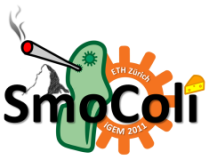Team:ETH Zurich/Biology/MolecularMechanism
From 2011.igem.org
| Circuit design |
| ||
| We combined a Xylene-sensitive band-pass filter with GFP output with a quorum-sensing diffusive mechanism that alarms the user of the system to high Xylene levels by expressing RFP. | |||
Circuit designTo generate a xylene gradient in our tube we included the upper Tol pathway of Pseudomonas putida in SmoColi. In Pseudomonas putida XylR controls the expression of the xylene degrading enzymes depending on xylene [1]. In our system xylene was used as an input for the bandpass-filter [2]. XylR was constantly expressed and enhances the expression of LacIM1 repressor (codon-modified LacI) and the lambda repressor CI, which are under control of the Xyl-Promotor, respectively. High xylene concentration results in high cytoplasmic levels of CI and of LacIM1 and repression of the green fluorescent protein (GFP). Cells that are far from the input have low xylene concentrations, because of xylene degradation. Accordingly, LacIM1 and CI are only expressed at basal level. Without repression of the lamda promoter wild-type LacI is produced and represses the production of GFP. At the same point the AHL Synthase LuxI is produced, AHL binds to LuxR which is constantly expressed and represses the red fluorescent protein (RFP). AHL is a quorum-sensing molecule with a high diffusion rate, it diffuses through the whole tube and represses RFP production in the whole tube, even in cells where no AHL is produced. If the xylene concentration is too high and it can not be degraded within the tube, no AHL is produced. Without AHL LuxR does not repress RFP and the whole tube turns red. To obtain better dynamics we tagged GFP and TetR with LVA tags.  Circuit operations for SmoColi exposed to medium, low and zero xylene concentration resulting in a GFP band (left) and at very high xylene concentration triggering the alarm and turning the whole system red (right). Triangles indicating the gradient of AHL (blue) and xylene(violett), receptively. Non active interactions and non expressed Proteins are indicated light colors |
Plasmid strategyhttp://www.springerlink.com/content/3fj1xxl9p42kx8l5/ |
References[1] [http://aem.asm.org/cgi/content/abstract/64/2/748 Sven Panke, Juan M. Sánchez-Romero, and Víctor de Lorenzo: Engineering of Quasi-Natural Pseudomonas putida Strains for Toluene Metabolism through an ortho-Cleavage Degradation Pathway, Appl Environ Microbiol, February 1998, 64: 748-751] [2] [http://www.nature.com/nature/journal/v434/n7037/full/nature03461.html Subhayu Basu, Yoram Gerchman1, Cynthia H. Collins, Frances H. Arnold & Ron Weiss: A synthetic multicellular system for programmed pattern formation, Nature 2005, 434: 1130-11342] |
 "
"

